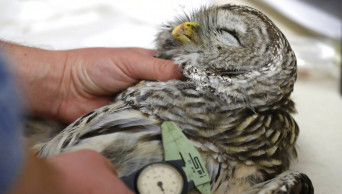Human
Fence to be erected in parts of Sundarbans to tackle human-tiger conflicts
The Forest Department of Bangladesh will install nylon fence at critical locations in the Sundarbans and provide awareness training, aiming to resolve tiger-human conflicts, and increase the tiger population in the world’s largest mangrove forest.
These initiatives are part of a special project of the Forest Department named 'Sundarbans Tiger Conservation Project'.The implementation of the project, with a budget of Tk 35.90 crores, began in April 2022 scheduled for completion in March 202, according to the project director’s office.
Read: Govt measures boost hilsa production in Khulna
Under this project, various activities were planned including a survey of the tigers and prey animals in the Sundarbans, the construction of high dunes and watchtowers, research on canine distemper virus in tigers, and awareness training for VTRT and CPG members, it said.
To prevent tigers from entering nearby localities from the Sundarbans, nylon fence will be erected in 4 to 5 km critical locations initially. If this proves successful, 60 km area will be brought under fencing.
The Forest Department expressed hopes that the successful implementation of this project will resolve tiger-human conflicts, reduce human-induced tiger killings, and increase the tiger population.
Read: Khulna fuel traders start indefinite strike with 3-point demand
The primary focus of the project is the survey of tigers and prey animals. So far, camera trapping surveys have been completed for tigers, prey animals, and canals in the Khulna and Satkhira ranges under Sundarbans West Forest Division.
The survey in the Sharankhola and Chandpai ranges under East Forest Division is set to commence in November, with the report expected to be published in July 2024.
Abu Nasser Mohsin Hossain, Divisional Forest Officer of Sundarbans West Forest Division and Project Director of the Sundarban Tiger Conservation Project, said camera trapping work for the tiger survey in Satkhira and Khulna ranges has been successfully completed.
All officers and employees of the Sundarbans East and West Forest Divisions will undergo training to enhance their tiger conservation skills.
Read: Rail link with Khulna restored after 7 hours
“Training sessions for CPG and VTRT members will start soon. Additionally, several activities are planned for tiger conservation and increasing their numbers,” he said.
“All project activities will be documented on video, and these recordings will be used to create documentary films. These films will later prove valuable to officials and volunteers dedicated to Sundarbans and tiger conservation,” he added.
According to the project plan, 12 high dunes will be constructed inside the Sundarbans to offer shelter to tigers during floods, storms, and high tides. A tower will also be installed in the Dhansagar area of the Sarankhola range tiger sanctuary to monitor fires. From this tower, forest guards and volunteers will be able to swiftly manage fires in the Sundarbans in that region.
As part of the project, research will be conducted on the canine distemper virus. Tiger feces will be collected from the Sundarbans, and domestic researchers will study the virus infection in the tigers' teeth through these fecal samples.
Read: Onion prices soar in Khulna market after India slaps duty on export
On the other hand, 340 members of the Village Tiger Response Team (VTRT) and 184 members of the Community Patrol Group (CPG) will receive training to resolve human-tiger conflicts in the Sundarbans.
Additionally, two tigers that often enter the locality will be fitted with satellite trackers. Forest officers will provide apps to CPG and VTRT members for tracking tigers' movements, allowing them to monitor tiger activity on their mobile phones. Consequently, if a tiger approaches the locality, they will be able to quickly guide it back to the Sundarbans.
Furthermore, for the project's implementation, various equipment such as drone cameras, satellite trackers, nylon fences, GPS devices, tranquilizing agents for tiger sedation, cameras, VTRT equipment, and various auxiliary materials, including clothing and training materials for CPG members, will be procured.
Read more: Save Sundarbans, save Bangladesh: Environmentalists call for protecting largest mangrove forest
2 years ago
Human error led to Indian military chief's chopper crash, says report
"Human error in cloudy weather" led to the chopper crash that killed India's first military chief General Bipin Rawat, his wife, and 12 other armed forces personnel last month, a tri-services probe has concluded.
According to the probe report, a sudden cloud cover over Coonoor district in the hilly terrain of the Nilgiris in the southern state of Tamil Nadu led to the military chopper's "unintentional collision with a mountain" on December 8.
Head of the Indian Air Force Air Chief Marshal Vivek Ram Chaudhari shared the tri-services probe report with Defence Minister Rajnath Singh on Wednesday.
READ: Sole survivor of Indian military chief's chopper crash dies
Tri-services probe means an investigation by the three branches of the military -- the Indian Army, the Navy, and the Air Force.
The 63-year-old Chief of Defence Staff was on his way to deliver a lecture at Defence Services Staff College in Wellington when the Mi-17 V5 chopper crashed in the Nilgiris and burst into flames.
"With deep regret, it has now been ascertained that Gen Bipin Rawat, Mrs Madhulika Rawat (wife) and 11 other persons on board have died in the unfortunate accident," the Air Force tweeted. Another victim, a senior Air Force, official died later.
Moments later, Indian President Ram Nath Kovind, the supreme commander of the armed forces, tweeted to say that "the nation has lost one of its bravest sons". Prime Minister Narendra Modi, on his part, had described the four-star General as "an outstanding soldier".
READ: India orders tri-services probe into military chief's chopper crash
General Rawat has had a chequered career in the armed forces spanning over 40 years, rising from the rank of a junior commissioned officer to the Indian Army chief and eventually the first head of the tri-services. He reported directly to the Indian Prime Minister.
3 years ago
First virtual human to join Huawei Cloud
The first virtual human, Yunsheng, will join Huawei Cloud, Zhang Ping'an, CEO of Huawei Cloud and president of Huawei Consumer Cloud Service, said at the ongoing Huawei Connect 2021.
Building on its digital content production line, Huawei Cloud created Yunsheng.
Technical innovations such as OptVerse AI Solver, Pangu drug molecule model, Blockchain Service, and the FunctionGraph function computing service have also been disclosed at the event.
READ: Huawei Connect 2021 begins
"Digitalisation is a wealth of opportunities, and we call on all to think cloud native, act cloud native," Zhang said.
Huawei Connect 2021 will continue until October 31. This year's event is focusing on the practical application of technologies like cloud, AI, and 5G in all industries and how they can make organisations of all shapes and sizes more efficient, more versatile, and ultimately more resilient as we move towards economic recovery, according to a media statement.
READ: Canadians released after Huawei CFO resolves US charges
4 years ago
Owl vs. owl: Should humans intervene to save a species?
Corvallis, Oct 19 (AP/UNB) — As he stood amid the thick old-growth forests in the coastal range of Oregon, Dave Wiens was nervous. Before he trained to shoot his first barred owl, he had never fired a gun.
6 years ago

.jpg)
.jpg)


